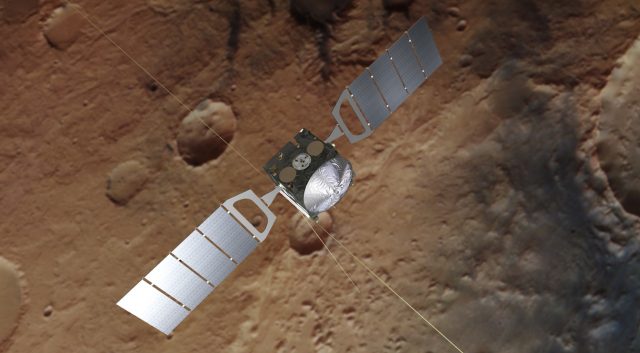This site may earn affiliate commissions from the links on this page. Terms of use.
Sending something to Mars is a major undertaking even today, and decades ago it was even harder. That’s why you have to build space hardware to last, and the European Space Agency (ESA) certainly did that with the venerable Mars Express probe. After almost 20 years, this mission is still going strong, and it’s even gaining new capabilities. But to get there, the ESA had to replace the probe’s ancient software, which was originally developed in a Windows 98 developer environment.
Mars Express reached the red planet in 2003, equipped with a raft of atmospheric and surface sensors, as well as the Beagle 2 lander. Unfortunately, the lander never phoned home after deployment. It was unclear what happened to it until NASA’s Mars Reconnaissance Orbiter spotted it in 2015. Its solar panels failed to deploy, blocking the antenna array. Still, Mars Express has more than pulled its weight. The Mars Advanced Radar for Subsurface and Ionospheric Sounding (MARSIS) instrument has been particularly important. It previously helped scientists discover signs of liquid water buried under the dusty plains of Mars.
After all these years, the ESA team is interested in pushing MARSIS to the limit, and that means it needs a software update. However, the Windows 98 code on the embedded system is not up to the task. But how do you change Windows 98-designed software from 120 million miles away? Not easily. Just designing a development environment on Earth that could talk to the probe’s computer was a two-month endeavor.
How do you update Windows 98 on a spaceship orbiting Mars? @esa is doing it for Mars Express, after 19 years. https://t.co/DRWtuaqo22 pic.twitter.com/xxkDz5GrL1
— Chris Hadfield (@Cmdr_Hadfield) June 22, 2022
The new probe software was built at Istituto Nazionale di Astrofisica (INAF) in Italy and is now being deployed by the ESA. Once fully installed, MARSIS will be able to study important features on Mars and its moon Phobos that were previously too complex to tackle. The new software will allow MARSIS to get more data from the surface and process it more efficiently, whereas before it would run out of memory very quickly. Essentially, the computer will be able to discard unneeded data, which means more value from each and every transmission to Earth.
The team hopes that the refreshed Mars Express will be able to identify more potential sources of water on the red planet. As humanity barrels toward a potential multi-planetary future, it will be vital that we know where we might find water. Not only could it sustain human explorers, but water can also be turned into fuel for rockets that bring people back to Earth or even send them farther out into the solar system.
Correction: This post originally stated that the Mars Express probe ran Windows 98. The original developer environment for the probe software was built around Windows 98, but the probe itself is not x86-based and does not run any variant of Windows. ExtremeTech regrets the error.
Now Read:
Source by www.extremetech.com





























